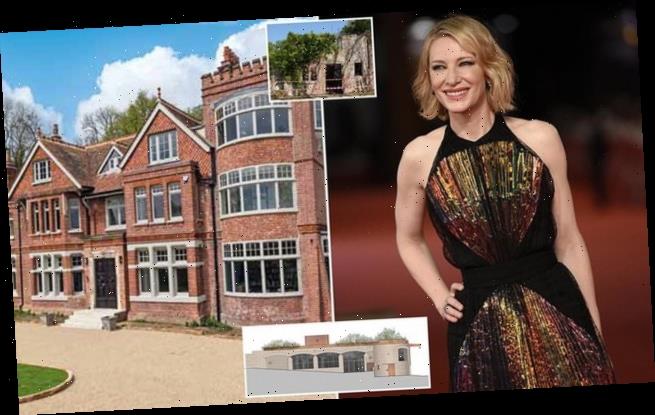Cate Blanchett wins permission for meditation room at her ‘haunted’ £4.9m Sussex mansion despite discovery of bat colony
- The Australian star lodged the plans for her home in Crowborough, East Sussex
- She wants to replace two buildings with a modern garden office and a studio
- But plans were halted after the discovery of bat droppings in the old buildings
- Council planners have green lit proposals but want a special strategy drawn-up
Hollywood actress Cate Blanchett has won planning permission to build a garden office complete with meditation room at her ‘haunted’ £4.9million mansion – despite the discovery of a colony of bats.
The Australian star, 51, wants to demolish a cottage and shed on the grounds of her stunning manor in Crowborough, East Sussex.
The two-time Oscar winner plans to replace the dilapidated buildings with a contemporary garden office, kitted out with a studio and meditation room.
However The Lord of the Rings star and her husband Andrew Upton, 54, were forced to hit the brakes on the demolition plans earlier this year, after the discovery of bat droppings.
Council chiefs have now given the green light to the proposals, but have demanded a plan for the bats is put together and approved first.
Hollywood actress Cate Blanchett has won planning permission to build a garden office complete with meditation room at her ‘haunted’ £4.9million mansion
The Australian star, 51, wants to demolish a cottage and shed on the grounds of her stunning manor in Crowborough, East Sussex (pictured)
The two-time Oscar winner plans to replace the dilapidated buildings (pictured) with a contemporary garden office, kitted out with a studio and meditation room
Council chiefs have now given the green light to the proposals (pictured: An elevation plan), but have demanded a plan for the bats is put together and approved first
Like all bats in the UK, brown long-eared bat and the common pipistrelle bats are protected in law.
Despite both species being widespread throughout the UK, numbers of bats generally have declined dramatically due to the impact of humans on feeding habitats and sight lines.
The common pipistrelle is the UK’s most common bat
It is estimated that the population of the pipistrelle, the most common bat in the UK, declined by 70 per cent between 1978 and 1993.
They have started showing signs of recovery in recent years.
Alongside being the most common, the pipistrelle is also the smallest UK bat. Bats of this species are so small in fact, that they can fit inside a matchbox.
However they have a mighty appetite – often eating up to 3,000 insects a night.
They generally live for up to five years and are seen between April and October.
This is similar to the brown long-eared bat – a medium sized bat with, as the name suggests, big ears.
As with all UK bats, they are nocturnal, only coming out at night to feed on midges, moths and other flying insects.
As part of a report, it was found that the shed, where the ‘tranquil retreat’ was due to be built, was deemed to have ‘high suitability for roosting’.
The cottage, meanwhile, was found to have a ‘low suitability’.
However both will require a licence to carry on knocking them down.
According to planning documents lodged with Wealden District Council, return-to-roost surveys and DNA analysis of droppings confirmed ‘the presence of a common pipistrelle bat summer roost’
‘There is also a potential occasional brown long-eared bat feeding roost,’ the report adds.
Common pipistrelle bats and brown long-eared bats are both considered to be protected species.
Any buildings containing a roost cannot be demolished without a European Protected Species licence from Natural England.
The plans to demolish the garden buildings have now been approved, but the council states: ‘Emergence and return-to-roost surveys, alongside DNA analysis of droppings, have confirmed the presence of a common pipistrelle bat summer roost and a potential occasional brown long-eared bat feeding roost.
‘Prior to the demolition of any of the existing buildings on site, a bat mitigation strategy shall be submitted to and be approved in writing by the Local Planning Authority.
‘This shall include details of the mitigation and compensation measures to be adopted and details of the European Protected Species licence.
‘This is to identify and ensure the survival and protection of important species and those protected by legislation that could be adversely affected by the development.
‘Works shall thereafter be implemented in accordance with the approved details.’
The state of the art studio and office, which will have three levels and a walled lavender garden, will also have to install ‘bat boxes’.
Alternatively, under the plans, a special ‘bat loft’ to be incorporated into the design.
Previous occupants of the mansion, built in the 19th century on 13 acres of land, include Sherlock Holmes creator Sir Arthur Conan Doyle and Doctor Who actor Tom Baker.
The Victorian country home has seven bedrooms, seven bathrooms and five reception rooms.
Source: Read Full Article





